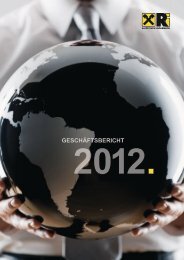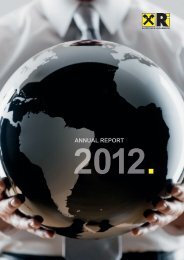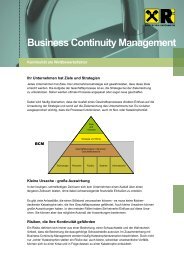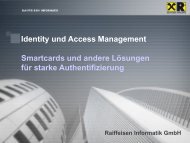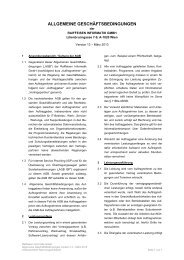ANNUAL REPORT - Raiffeisen Informatik
ANNUAL REPORT - Raiffeisen Informatik
ANNUAL REPORT - Raiffeisen Informatik
- No tags were found...
You also want an ePaper? Increase the reach of your titles
YUMPU automatically turns print PDFs into web optimized ePapers that Google loves.
V.2. RESPONSIBILITY FOR THE ENVIRONMENTV.2.1. ENVIRONMENTAL PROTECTION:FIGHTING CLIMATE CHANGE TOGETHERClimate change poses a great challenge to society,policymakers and the economy. Sustainable energypolicy is one of the key global issues of the future. The<strong>Raiffeisen</strong> Climate Protection Initiative is a platformand an ideas pool created in 2007 to bundle the activitiesof the <strong>Raiffeisen</strong> organisations in the area of climateprotection, energy efficiency and renewable energy.The goal is to raise awareness within the company andalso among the broad public externally for the subjectof climate protection and to inform on topical issuesand activities, especially as regards construction andrenovation as well as mobility and transportation. The<strong>Raiffeisen</strong> Climate Protection Initiative also has abusiness policy aspect. It is a platform through whichclimate protection projects are supported and furthered.Members of the <strong>Raiffeisen</strong> Climate Protection Initiativeare the 24 <strong>Raiffeisen</strong> organizations that in this mannertake over responsibility for the environment and therebycontribute substantially to climate protection. Therenovation measures funded by <strong>Raiffeisen</strong> have helpedto cut back an estimated 360,000 tonnes of CO²emissions over the past years. The <strong>Raiffeisen</strong> ClimateProtection Initiative believes it is on the right track topromoting climate protection and economic efficiency.<strong>Raiffeisen</strong> <strong>Informatik</strong> has been an active member of the<strong>Raiffeisen</strong> Climate Protection Initiative since 2007 andhas since then taken many measures to actively supportclimate protection. These include: vehicles and furnishingsfor buildings that help reduce the harmful effects onthe environment; alternative energy forms at diverselocations; quality management for licensing; regularlyreviews of energy consumption and the preparation ofresources balance sheet for the company.When purchasing new company vehicles, the fleetmanagement of <strong>Raiffeisen</strong> <strong>Informatik</strong> concentrates oncars with low emission levels and those that use hybridtechnology. <strong>Raiffeisen</strong> <strong>Informatik</strong> provides employeeswith day tickets for public transport as well as companybicycles when they need to travel short distances forthe company. The tickets and bicycles are easily obtainedfrom the concierge at the business locations. Thecompany also makes sufficient bicycle stands availablefor parking. In the area of procurement, it endeavoursto rule out the use of child labour in the products bought.A preference is given to domestic and regional suppliersas well as to local production sites and products withthe Fair Trade label. Moreover, attention is paid to ensuringan optimal price-to-benefit ratio. In the area of wastemanagement, waste separation by type of waste is givenhigh priority and the return hazardous waste is contractuallyagreed with suppliers.<strong>Raiffeisen</strong> <strong>Informatik</strong> encourages the use of energysavinglight systems for office lighting and self-regulatingcooling and heating equipment. Printed matter is printedexclusively on PEFC-certified materials. Professionalprint management was introduced to convert all printersin use at <strong>Raiffeisen</strong> <strong>Informatik</strong> into modern and economicmulti-functional devices to help reduce electricityconsumption, dust and toner emissions. Moreover, tipson how to save energy are disseminated regularly viathe Intranet and employees are instructed to turn off allcopy machines, scanners and printers after office hours.The entire power supply is reduced to a minimumovernight via a central control system.V.2.2. GREEN ITGrowing demand for IT services is resulting in a steadyincrease in the number of IT components (networks,servers and storage devices) at IT companies as theseare required to raise productivity. The higher electricityconsumption and need for cooling and air conditioningthis growth entails raises energy consumption and thusenergy costs unless countermeasures are taken. Themore energy efficient (environmentally-friendly and lowresource consumption) the IT services of a data centreare across the entire life cycle, the more competitivethe IT company. The sustainability of a data centre in themeaning of energy efficiency is made possible, amongother things, by inexpensive electricity procurement, theuse of energy-efficient hardware and facility installationsas well as through the use of virtual solutions. Thismakes it possible to use the “non-productive” energy,which was needed for the physical infrastructureup to then, to supply additional IT components and to cutelectricity costs.<strong>Raiffeisen</strong> <strong>Informatik</strong> sets great store by accountabilityvis-à-vis the environment and for this reason uses thelatest technologies to optimize energy consumption andeconomic efficiency. Virtualization technology help toenormously increase productivity while at the same timereducing energy costs. The use of new equipment atbuildings (energy-efficient transformers and revolutionaryhigh-capacity and UPS with dynamic operation modes,etc.) ensures energy efficiency at the main data centreand the highest level of availability, reliability, maintenanceand security.Furthermore, energy-saving emergency lighting systemsare used. Innovative cooling technologies guaranteecooling for the IT components at low electricity consumption.The innovative cooling concept consists of threemodern cooling machines with TURBOCOR compressorsthat use river water (Danube Canal) and evaporationcooling as well as cold aisle containment and re-circulatingcooling devices for industrial use. The re-circulatingcooling devices have fans powered by direct currentmotors that consume 30% less electricity than conventionalalternating current motors; these keep the tempe-ratureand humidity in the server rooms within the rangerecommended by the American Society of Heating andAir-Conditioning Engineers (ASHRAE). A new, intelligentlayout of the equipment and covers for areas not in useon the racks ensure the separation of cold air from thewarm air, and thereby help achieve optimal air circulationbetween the IT components. The heat generated at thedata centre is used for heating the adjacent office building.The efficacy of energy use at the data centre and theefficiency of the data centre infrastructure are monitoredby an energy monitoring system. This information makesit possible to verify more easily than up to now howchanges to the infrastructure affect energy efficiency, andtherefore, the overall energy balance.In August 2012, the cornerstone was laid for the newdata centre of <strong>Raiffeisen</strong> <strong>Informatik</strong>. The new building atthe outskirts of Vienna has been designed as one of thelargest data centres equipped with the latest technologyin Austria to process high data volumes. This datacentre will be one of the most performant and securedata centres in Austria. The scalable range of services isbased on virtualized computing and storage systems,and can be adapted dynamically to future demands ofcustomers. At this data centre, modern procedures andtechnology will be employed in an environmentally-friendlyIT system. Above all, a new technique will be usedto install an uninterrupted power supply, the so-called“rotating UPS”. A task that needed dozens of accumulatorsformerly can now be accomplished by a “flywheel”with low resistance which is kept spinning at high velocitypermanently. In the event of a power failure, the momentumof the “flywheel” continues to power a generatorfor around 30 seconds that produces electricity until thebackup diesel generator kicks in and is fully running.The modern data centre is scheduled to be handed overand commissioned at the beginning of 2014.Energy from renewable sources is given high prioritywhen procuring electricity. The electricity supplied to<strong>Raiffeisen</strong> <strong>Informatik</strong> is 100% from renewable energysources covered largely from European hydropower anddoes not generate any C02 emissions. This is certifiedby Energie Allianz Austria GmbH (certification “CleanElectricity” – Electricity from hydropower), Austria’slargest power utility.In 2011, for the first time, a project was launched tocompletely replace the microfiche files by a modern andlow-resource system. Lists kept up to then on microfichesand which constituted hazardous waste film materialare now processed electronically. The data is stored onservers at the high security data centre of <strong>Raiffeisen</strong><strong>Informatik</strong>. This helps protect the environment, becausethere is no need to produce more microfiches and neitheris there any need to dispose of the required chemicals.Moreover, the new archiving system features greaterease-of-use and reduces storage costs. The enormousefforts made by <strong>Raiffeisen</strong> <strong>Informatik</strong> to reduce resourceconsumption and protect the environment have receivedrecognition in the form of the ÖKOPROFIT environmentalaward of the ÖkoBusinessPlan programme that wasawarded already three times. The ÖkoBusinessPlan isan initiative of the city of Vienna (Department 22 – EnvironmentalProtection). The guiding principles of theÖkoBusinessPlan are: first, cleaner profits for theenvironment and companies by using environmentallyfriendlybusiness practices, and second, securing highquality and financial benefits for companies throughenvironmental protection.Financial Statements Certifications and Awards Risk Management CSR Group Management Report Group Profile Corporate Bodies / Shareholders Preface70 71




